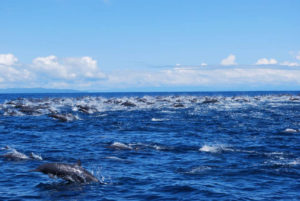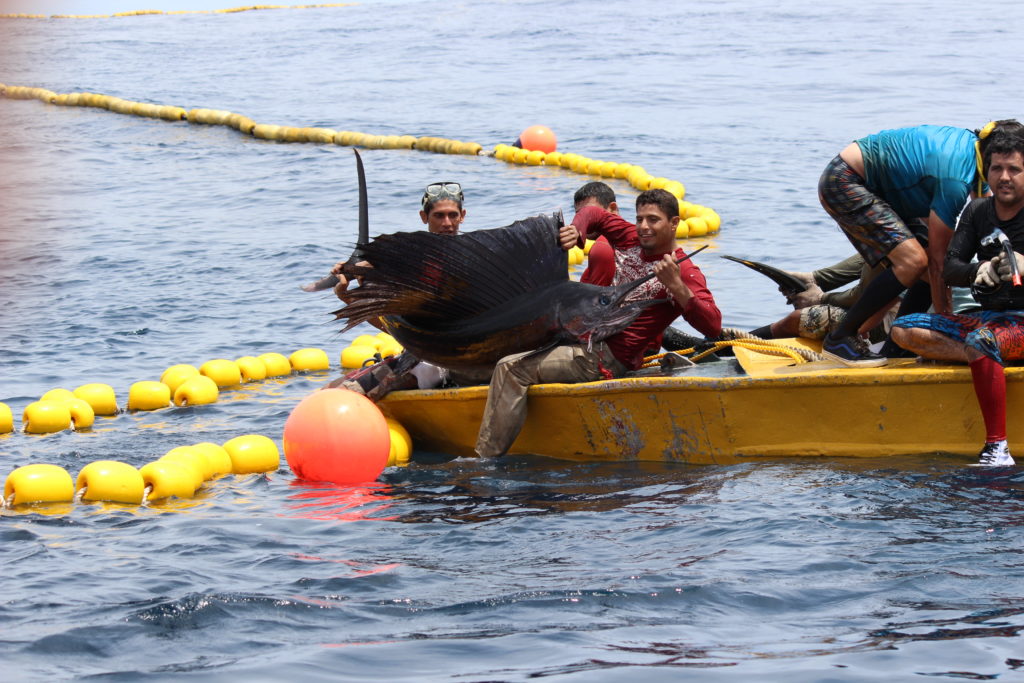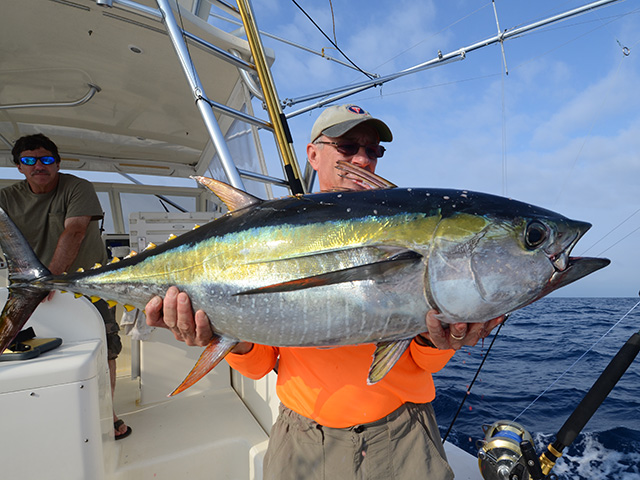Why is the Costa Rica Tuna Decree so Important?
Explaining the Costa Rica Tuna Decree
There is nothing like enjoying a fresh yellowfin tuna sushi, sashimi, or even a big fat juicy fresh tuna steak when your arms are almost too tired to lift the chopsticks. Recreational anglers are catching more tuna than ever all along the Costa Rican Pacific seaboard. Fighting yellowfin tuna on rod and reel is like having your line attached to a freight train. The increased availability of tuna has been a saving grace for many a charter captain in the off season for billfish.
People are asking: Why so many tuna?
In 2012 FECOP (Federacion Costarricense de Pesca), a non-governmental group made up of different sport fishing associations around the country began researching the tuna purse industry in Costa Rican waters. Territorial waters are 11 times greater than Costa Rica’s terrestrial area. Costa Rica does not have any national flagged tuna vessels and purse licenses are sold to and operated by foreign flagged vessels in Costa Rican waters. FECOP approached then President of Costa Rica Laura Chinchilla explaining a problem existed and she advised them to submit a project supporting their claim.
“It is estimated 25 tons of what would have been marlin bycatch in purse sein operations were saved in Costa Rican waters in 2017 alone.”
FECOP then discovered that over the 2008-2011 period, 193 purse vessels operated in Costa Rican waters while INCOPESCA the governing body of fishing in Costa Rica reported only 81 licensed vessels sold for the same period. Apparently 114 or 58% of the vessels were operating illegally. Much of the tuna never made it to port in the country. Costa Rica benefited a mere $37 a ton for tuna stored.
Knowing the government would be slow to react to just a group of sport fishers’ complaints, FECOP held meetings with the longline fleet. After decades of throwing stones at each other the two groups decided to present the project to the government together. The longline fleet expressed if there were a steady supply of tuna available they would have no interest in sailfish which are a major bycatch problem in Costa Rica with non-selective types of fishing gear.

President Chinchilla signed the “tuna decree,” as it is known near the end of her term and newly elected President Luis Guillermo Solis delayed the publication of the decree, but it eventually passed in October of 2014. The decree protects over 200,000 square kilometers of territorial water (44%) from purse sein operations, (see map). The most important area to recreational anglers is the first 45 miles from the coastline in which sein operations are now prohibited.

In March of 2017, using data supplied by FECOP’s Director of Science Moises Mug, INCOPESCA reduced tuna purse sein licenses sold to foreign fleets from 43 vessels down to 9 for the rest of the year. The government amended the agreement and sold 13 licenses. A new decree is waiting to be signed that would only permit 8 licenses permanently. It is estimated 25 tons of what would have been marlin bycatch in purse sein operations were saved in Costa Rican waters in 2017 alone.
According to agreements in the Tuna Decree there are a few provisions that have yet to be implemented. A management plan for the coastal and special polygons. Polygons A and D on map. An onboard observer program must be created for longline fleets, and a research program including horizontal and vertical migration using archival tags. The management workshops have already begun with sport and commercial fisherman, government agencies and NGO’s all participating.
INCOPESCA, INA the governmental technical institute that trains for many occupations including different types of fishing, and FECOP have all teamed up for a year- long greenstick and vertical line study which started with the first voyage in October. Greenstick is a method of fishing tuna with almost zero bycatch that is common in the Atlantic side of the United States but INCOPESCA requires technical support studies done in Costa Rica before they will give licenses for fish them here. With more tuna available and a growing demand for sustainably caught tuna on the International market with a higher value at the dock, hopes are one day a portion of the longline fleet will convert to greenstick fishing. This would decrease the amount of billfish bycatch.
FECOP was formed in 2008 by a small group of anglers who discovered 480,000 kilos of sailfish were being exported annually into the United States. Much of this was served in seafood restaurants as smoked seafood spread and people had no idea they were eating sailfish. FECOP convinced the government to stop the exportation of sailfish but it can still be sold on the National market as a low-cost supplement to the Costa Rican diet.

The first major conservation project FECOP tackled was the creation of the largest Marine Area of Responsible Fishing in Central America. Sport fishing is allowed and small scale artisanal fishing is permitted in the Golfo Dulce on the Osa Peninsula, but shrimp trawlers and gill nets are no longer allowed. A Golfo Dulce Commission was formed with representatives of all the users of the gulf as well as governmental agencies and NGO’s who meet monthly to manager the area.
FECOP has not existed without controversy. While the whole Costa Rican sport fishing community should have been celebrating the Tuna Decree when it passed, they were distracted by a campaign from The Billfish Foundation labeling FECOP as “quasi-green environmentalists” and a threat to sport fishing in Costa Rica. The controversy started when a FECOP member voiced his opinion at a public forum on regulating more the organized billfish tournaments in Costa Rica. TBF ran with it claiming it was FECOP’s stance to discredit the organization.
A blessing in disguise, the incident prompted FECOP to re-evaluate itself. The staff was reduced and Moises Mug, one of the most respected marine scientists in the country was hired full time. Today their agenda is quite simple. Promoting sport fishing in Costa Rica both recreationally and professionally with a focus on bycatch, research and communication. The staff is supported by a board of directors from both the recreational and professional fishing sector including sportsman and Hall of Fame baseball player Wade Boggs who is an avid fisherman and conservationist.
Continuous maintenance of the Tuna Decree will be needed in 2018 which Dr. Mug will oversee. Henry Marin will head up a socio-economic study concentrating on coastal communities individually, demonstrating the importance of sport fishing.
One study FECOP will be doing that will be especially exciting is Pacific Tarpon. Not indigenous to Pacific waters the numbers caught on the Pacific coastline has been increasing annually. It is suspected they have come through the Panama Canal and are breeding in Pacific waters. Fish will be captured, tagged, a tissue sample taken and then released. Genetics and feeding habits can be determined by a tissue sample. The study will be done in the southern zone where more fish have been taken, but tarpon have been caught up on the Nicoya Peninsula and one was caught recently as far north as El Salvador.
More information can be found about FECOP at www.fishcostarica.org
Sport Fishing Generates Nearly 500 Million Dollars Annually in Costa Rica
Costa Rica’s Marine Resources – Sport Fishing Isn’t The Problem






















3 Comments
great work pleased keep me advised
Been fishing CR since 1973. Can prove 36 trips from the Boston area.
We caught some of everything! Son caught a fine tuna and gave it to the chef. We had great raw tuna that night; nothing better!!!!
What a trip, what fishing and what a great bar with fine dining after reviewing the day’s activities.
J Fields MD